- Resources
- /
- Changelog
Hosted Agent Outbound IP Address Ranges Updating January 1, 2026
The outbound IP address ranges used by Hosted Agents are being updated. The updated ranges are now visible in your Cluster's Networking page, but will not take effect until January 1, 2026. The new, larger ranges provide additional IP address space to support increasing workloads.
If you maintain IP allowlists or firewall rules, please review and update them before January 1 to ensure uninterrupted access.
Have questions or need help? Reach out to us at support@buildkite.com
Daniel
bktec v2.0.0 - now with dynamic parallelism
We have released a new major version of the Buildkite test engine client (bktec).
This version introduces dynamic parallelism, intended to accommodate builds where the number of tests run is variable, for example when predictive test selection is used.
From v2.0.0 bktec can dynamically set command step parallelism to achieve a specified target build duration.
📚 Learn more about bktec dynamic parallelism.
Note on upgrading to bktec v2.x.x sub-command support has been added in this release.
Calling bktec without a sub-command is no longer supported, so when upgrading to v2.x.x please update your step definitions.
# < v2.0.0
command: bktec
# >= v2.0.0
command: bktec runMalcolm
Display properties customization
You can now toggle display properties in your test data tables. Turn on/off fields like State, Location, Repository, and Labels so you only surface the context that’s relevant to you and clear out any extra clutter.
Customizable display properties are available in:
- The Tests tab for a build or a build's job
- The Tests view and when viewing saved views in Test Engine
- The single run view in Test Engine
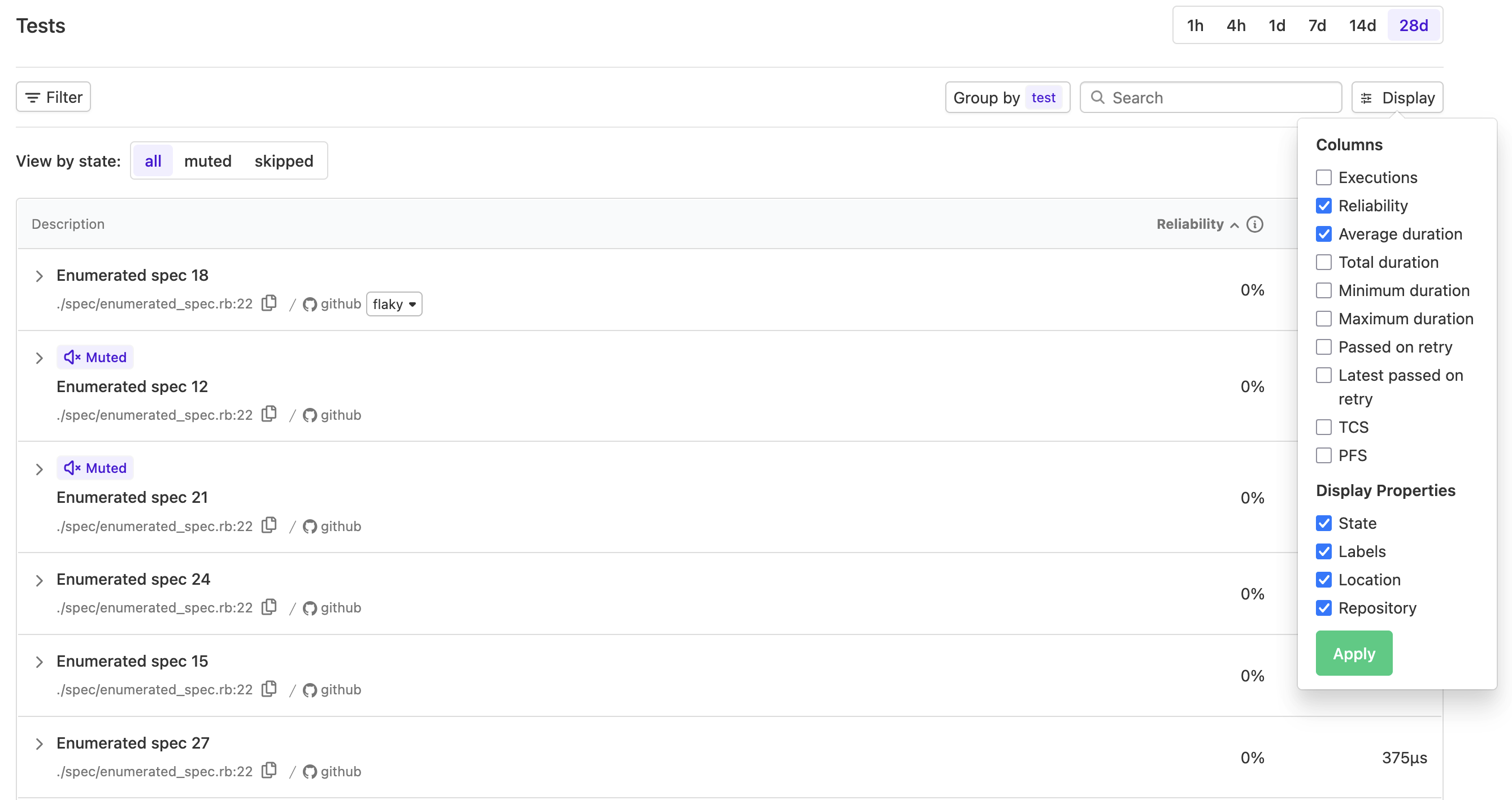
Saved views have also been updated, allowing your selected display properties to be stored as part of the saved view configuration. This ensures your preferred layout is preserved and shared across your suite.
Meghan
Control where your retries run with Retry Agent Affinity
A common frustration when running in CI is that agent instances can become corrupted in such a way where they are no longer able to consistently run jobs. This can lead to retries failing, which can be difficult to diagnose and fix. Within Buildkite, by default, jobs are run on the agent that has most recently finished a job, which can lead to retries running on the same agent that failed the first time causing repeated failures.
With the new Retry Agent Affinity feature, you can control where your retries run. Retry agent affinity is set at the Cluster Queue level, and when set to prefer-different, will prefer to run retries on a different agent than the one that failed the first time. This can help to avoid retries failing due to repeated runs on the same corrupted agent.
To set the Retry Agent Affinity on a cluster queue, you can go into the Cluster Queue settings and select the Retry Agent Affinity option:
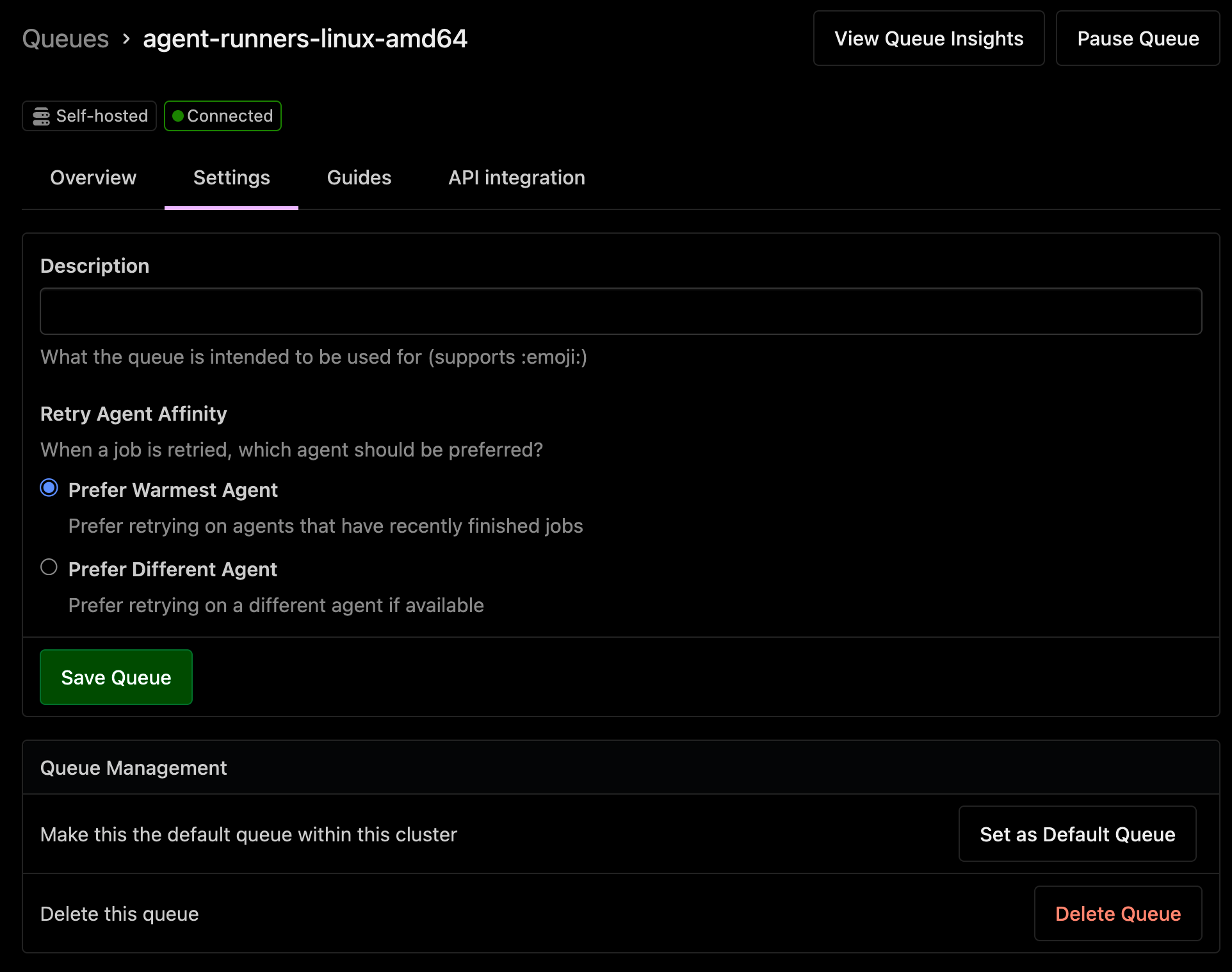
Alternatively, this value can be set via both the REST and graphQL APIs.
Availability
Retry agent affinity is available for all self-hosted cluster queues.
If your agents are using an acquire-job workflow such as agent-stack-k8s, the setting will have no effect, as Buildkite doesn't control job dispatch for these agents.
Retry agent affinity can't be set on hosted queues, as agents in hosted queues are ephemeral, and so retries will always run on different agents from the original job.
Benno
New Test monitor for Test Engine Workflows
You can now detect and manage newly introduced tests with the New Test monitor in Test Engine Workflows!
The New Test monitor automatically detects newly introduced tests to your test suite. By triggering appropriate actions to track and validate the performance of new tests, you can proactively manage these new tests and ensure you're not introducing flaky tests into your test suite.
What's new
- Detect newly introduced tests in your test suite automatically
- Full workflow action support including labeling, state management, Slack notifications, and Linear issue tracking
- Tag-based filtering to trigger actions only for new tests with specific tags
Learn more about the New Test monitor in our documentation.
Naufan
Group executions by location and tag
We're excited to announce that test executions can now be grouped by location and tag! Grouping executions makes it easier to compare related tests side-by-side, helping you quickly spot patterns, outliers, and performance differences. This is especially useful for teams that use tags to classify tests by component, owner, type, cloud provider, or any other custom metadata.
The new grouping functionality is available in three areas of the platform:
- In the Tests tab for a build or a build's job (shown below)
- In the Tests view and when viewing saved views in Test Engine
- When viewing a particular run in Test Engine

If you're not currently collecting tag metadata for your test executions, read the docs to learn more.
Steve
Elastic CI Stack for AWS now available as a Terraform module (Preview)
We're excited to announce our Terraform module for the Elastic CI Stack for AWS is now in Preview!
For teams who prefer infrastructure-as-code with Terraform over CloudFormation, you can now deploy and manage your autoscaling Buildkite agent clusters using familiar Terraform workflows.
This Terraform module supports all the features available in our Elastic CI Stack for AWS:
- Autoscaling based on agent utilization metrics
- Support for both Linux and Windows agents
- Configurable spot and on-demand instances
- Built-in secrets management via S3 and AWS Secrets Manager
- Pipeline signing with KMS
- Scheduled scaling for cost optimization
The module is currently in preview. If you encounter any issues or have feedback, please raise an issue on GitHub or reach out to support@buildkite.com.
Check out Setup with Terraform in our docs, the module's GitHub repository, and our example configurations to get started.
For those who prefer CloudFormation, the Elastic CI Stack for AWS is also available as a CloudFormation Stack.
Joe
New golangci-lint plugin released
Running golangci-lint is now even simpler, with the release of the golangci-lint plugin for linting and formating Go code in your CI/CD pipeline.
The plugin makes it easy to integrate Go code quality checks into your Buildkite pipelines with minimal configuration. It runs golangci-lint using Docker by default, but can also use a local binary if preferred.
Basic usage
Add the plugin to your pipeline with minimal configuration:
steps:
- label: "Go Lint"
plugins:
- golangci-lint#v1.0.0: ~For complete documentation and all available options, see the golangci-lint plugin.
Ben
New deployment plugins released
We're happy to announce that we have developed three new plugins that enable easy deployments and rollbacks using several popular code deployment tools.
The AWS Lambda Deploy plugin supports AWS Lambda deployments and rollbacks. It can deploy both zip files and container images, and uses aliases to enable blue/green deployments. Optional features include automatic rollback in case of failure, and a customizable health check for verifying the deployment. The plugin will also create detailed build annotations about the deployment and rollback process, for post-build review.
The ArgoCD Deployment plugin supports ArgoCD deployments and rollbacks. It leverages the ArgoCD API to perform health checks after the deployment is complete, and collects application and pod logs to upload as build artifacts for later review. It also includes support for sending your team Slack notifications when appropriate, as well as customizable manual rollback workflows.
The Deployment Helm Chart plugin supports simple deployments and rollback workflows using Helm. Specify your chart, release name, namespace, and optional values, and the plugin will take care of the rest. Rollbacks can be triggered by a user after manual application health checks.
Follow the links above for complete usage information for each of these plugins. Have questions or need help? Reach out to us at support@buildkite.com
Owen
Jenkins Pipeline Translation in Migration Tool
You can now bring your Jenkins pipelines over to Buildkite even faster! Our migrate tool now supports pasting in your declarative or Groovy Jenkinsfile and will automatically translate it into Buildkite steps.
This makes it simple to:
- Copy an existing Jenkins pipeline
- Instantly see the equivalent Buildkite pipeline steps
- Speed up migrations with less manual rewriting
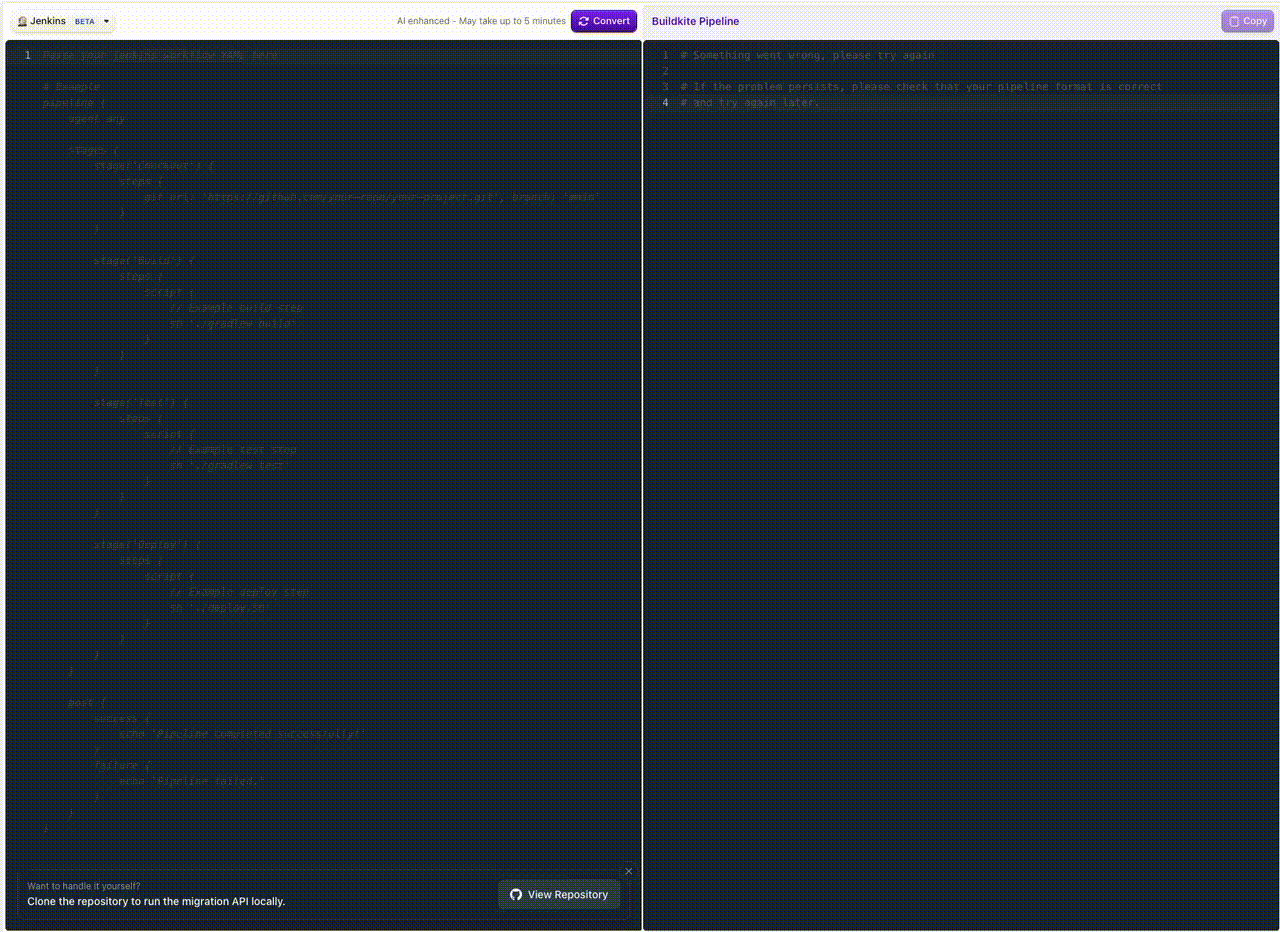
👉 Try it out in the Migrate Tool
📖 See the documentation
Ben
Restrict API token creation for organization members
Organization admins can now restrict organization members from creating new API access tokens, providing better control over API access management across your organization.
This new security setting is available in the Security > API tab of your organization settings. When enabled, only organization administrators will be able to create new API access tokens for the organization.
Key details
- Existing tokens remain functional: All previously created tokens continue to work as expected. This setting only affects the creation of new tokens.
- Admin exemption: Organization administrators can always create tokens, regardless of this setting.
For more information about API access tokens, see the API access tokens documentation.
Himal
GitHub merge queue integration
Buildkite now has built-in support for GitHub merge queues. You can now opt into creating and canceling builds based on merge_group webhook events from GitHub. These builds are identified as merge queue builds in the Buildkite UI, and build behavior can be customized based on merge queue-specific attributes.
🆕 What’s new

- Create builds when a merge group is added to the merge queue: Rather than rely on triggering a build based on unique
gh-readonly-queue/*branches, builds can now be triggered in response to amerge_groupwebhook event. - Optionally cancel in-progress builds when a merge group becomes invalid: Cancel any running builds belonging to a destroyed merge group (e.g. when the merge queue entry is replaced due to a pull request being removed from the queue).
- Identify merge queue builds in the Buildkite UI: Merge queue builds are listed separately at the top of the pipeline page, and builds can be filtered by the merge queue they belong to.
- Vary pipeline behavior for merge queue builds: Utilize new build conditionals (
build.merge_queue.base_commit,build.merge_queue.base_branch) and environment variables (BUILDKITE_MERGE_QUEUE_BASE_COMMIT,BUILDKITE_MERGE_QUEUE_BASE_BRANCH) to modify the behavior of your pipeline. - Avoid redundant work using
if_changedduring step uploads: For appropriate merge queue configurations, the agentif_changedattribute can useBUILDKITE_MERGE_QUEUE_BASE_COMMITto determine which steps to run based on the contents of the pull request – particularly useful for monorepos.
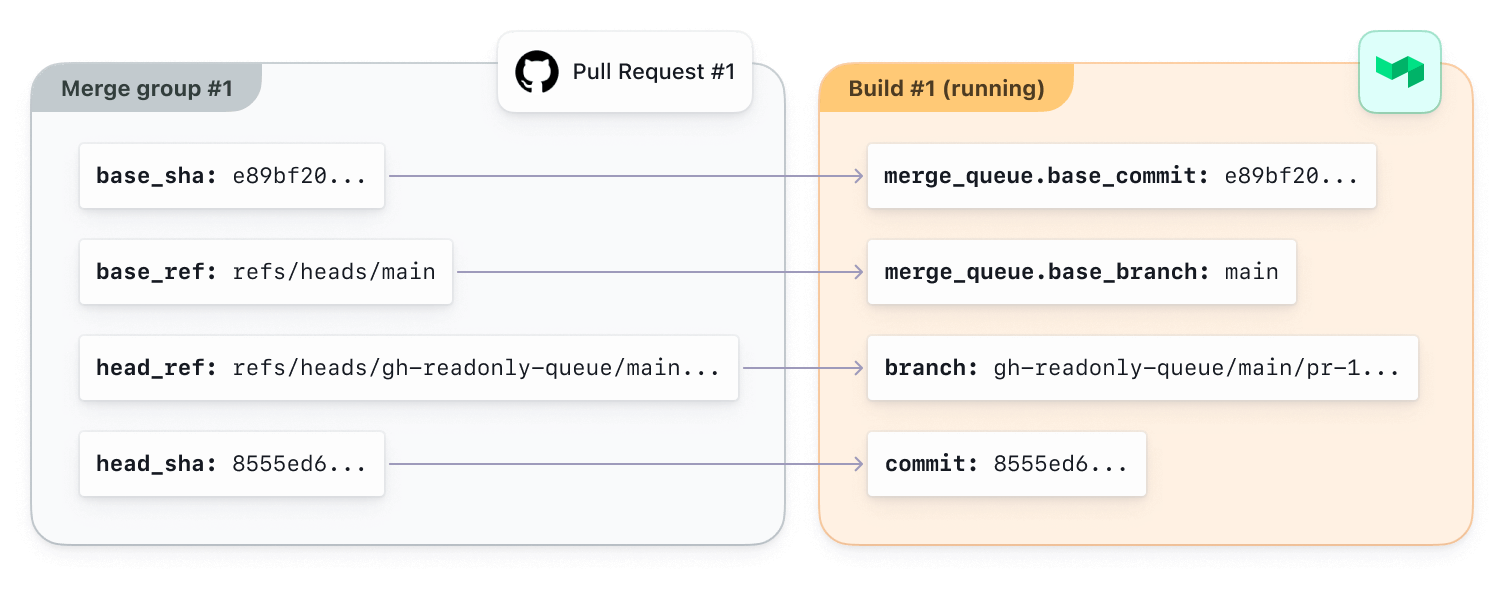
For full details about these features and the interaction between GitHub merge queues and Buildkite see our tutorial or watch the video below:
Mark
Access control and YAML integration for secrets
We are excited to share the latest security and usability improvements we have made to Buildkite secrets, a secure key-value store for managing sensitive data across your pipelines.
Direct integration into YAML steps
While you can still access secrets through the buildkite-agent secret get command, we have now introduced the ability to load secrets directly into your jobs' environment using a new secrets key in your pipeline YAML.
# Loaded into environment for all steps in the build
secrets:
- API_ACCESS_TOKEN
steps:
- command: scripts/deploy.sh
# Loaded into environment for this step only
secrets:
- DEPLOY_KEY
- command: scripts/lint.shIn order to reference Buildkite secrets via pipeline YAML, buildkite-agent v3.106.0 or later is required.
Policy-based access control
Policies let you restrict secret access within a cluster based on the context of a build - from broad access from an entire cluster to specific conditions like particular pipelines, branches, or users.
For example, to only allow access from main builds from a chosen team on a given pipeline:
- pipeline_slug: "my-pipeline"
build_branch: "main"
build_creator_team: "e2b7c3f4-1a5d-4e6b-9c8d-2f3a4b5c6d7e"For the full list of claims and further examples, see the secrets documentation.
David
Test Engine Workflows
We’re excited to introduce a new feature in Test Engine: Workflows!
Workflows surface qualitative insights about your test suite that can be hard to extract from raw execution data alone. They let you create custom mappings between the observations Test Engine makes about your tests and the actions you want to take in response. With workflows, teams can streamline their testing process, detect flaky tests with greater precision, and boost productivity through automation.
🆕 What’s new
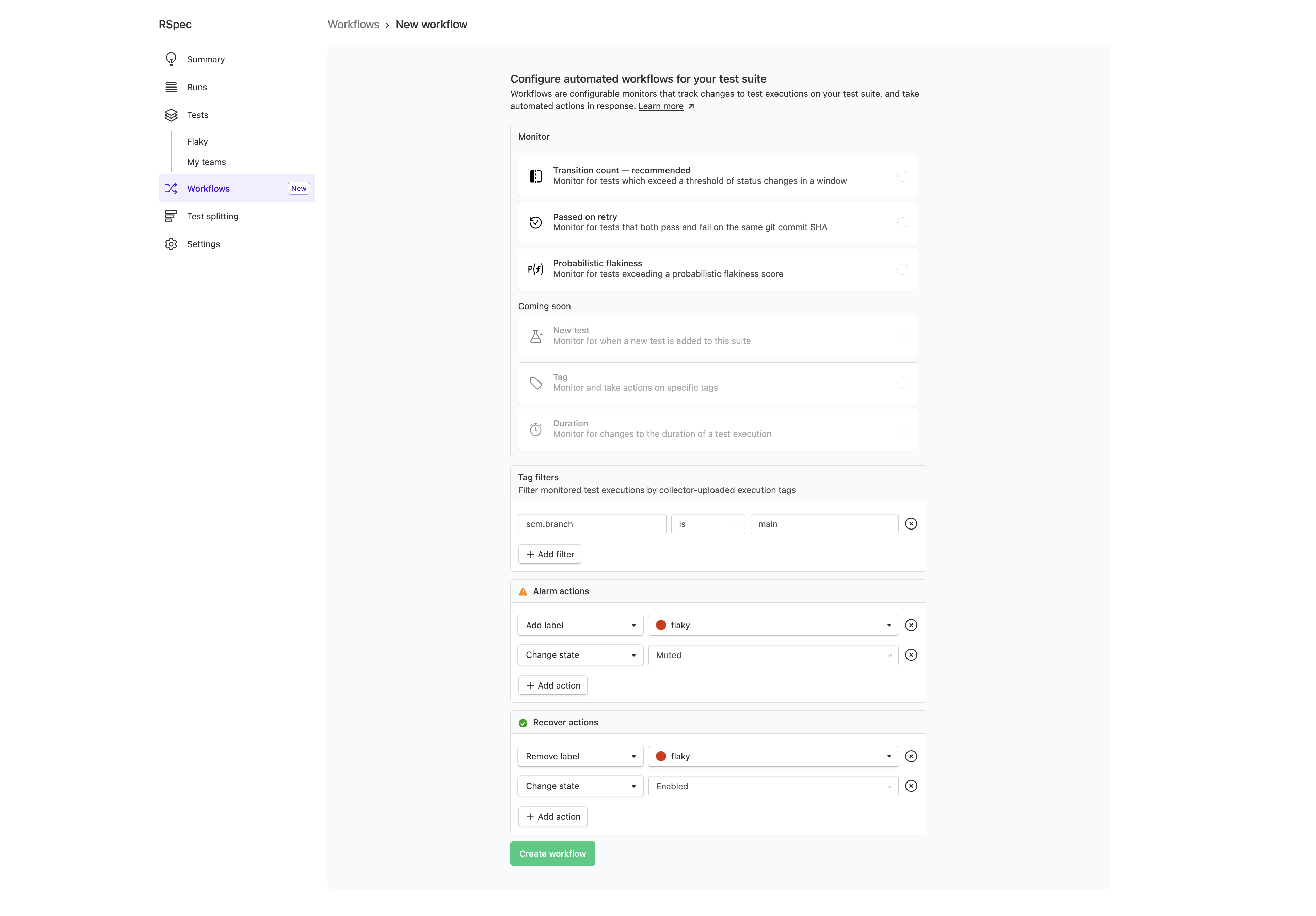
- Detect flaky tests with multiple heuristics: Identify unreliable tests with three detection models — passed on retry, transition count, and probabilistic flakiness score.
- Fine-grained control: Create separate workflows for different test types, teams, or environments to match the way your organization works.
- Customizable test management: Turn flaky test detection into immediate actions. Automatically label tests and change test states.
- Notifications: Send notifications about flaky tests via webhooks and Slack. Enrich Slack messages with test metadata.
- Issue tracking: Manage the resolution of flaky tests by integrating with your external issue tracker, and track its progress.
- Linear integration: Automatically create Linear issues for flaky tests. All issues appear directly in the test view for easy tracking and follow-up.
How to get started
Workflows are included in Test Engine and available to try today. Customers on Pro and Enterprise tiers can currently use up to 3 workflows per suite.
Watch the demo or read the docs to learn more.
Happy testing!
Meghan
Private Storage Link for Google Cloud Platform (GCP)
We've expanded Private Storage Link (PSL) to support storing packages on Google Cloud Platform (GCP). Customers can now choose either AWS S3 or GCS when configuring global and per-registry storage locations.
Steven
Xcode 26 is now available on Hosted Agents for macOS
We've added support for the latest Xcode 26 to our macOS instances, this can be selected with macOS Sequoia (15.6.1) and Tahoe (26).
We encourage everyone who has been testing the Xcode betas and release candidates to move to the release version.
Have questions or need help? Reach out to us at support@buildkite.com
With super fast startup times, clean ephemeral environments for each job, the latest Xcode updates and developer tools ready to go - and now powered by M4 Pro - Buildkite Hosted Agents for macOS are built for fast, reliable CI at scale.
Mark
Enhanced filtering and layout improvements in Test Engine
We've enhanced the Test Engine UI with new filtering capabilities and layout improvements. This bring improved flexibility to your ability to analyze test metrics.
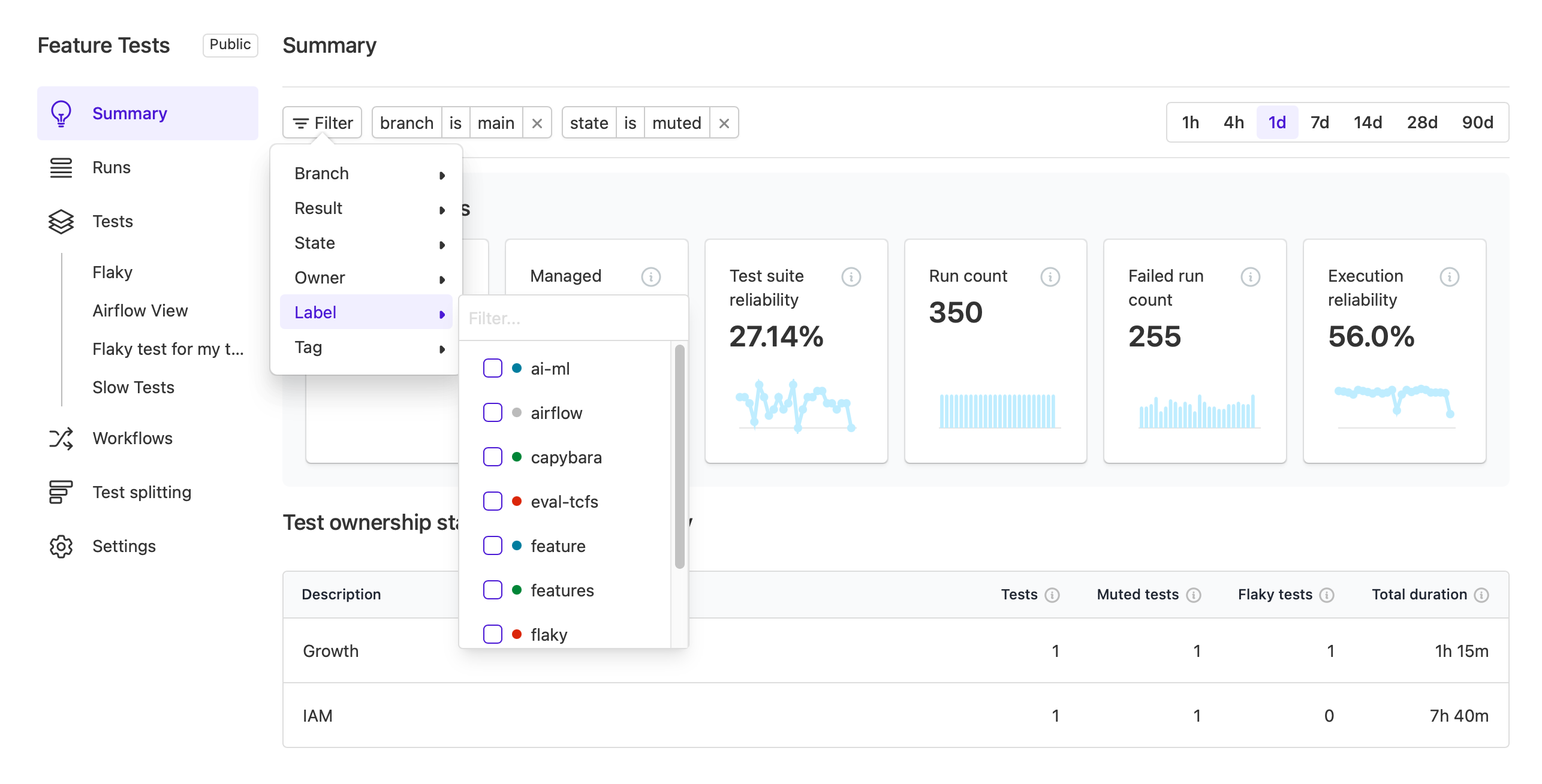
Enhanced filtering throughout Test Engine
The new filter component has been uplifted to give you easier access to all relevant filters. You can now filter test executions by:
- Branch - Filter tests that were executed on a specific branch
- State - Filter tests that are muted or skipped
- Result - Filter test executions by passed or failed result
- Owner - Filter tests owned by specific teams
- Label - Filter tests that have specific labels
- Tags - Filter test executions with specific set of tags
These filters are now available across:
- Suite Summary page
- Run details page
- Test details page
- Pipeline build page
Smarter metric insights
Metric cards in the Suite Summary, Run details, and Test details pages now reflect your selected filters, giving you instant insights into metrics for the tests that matter most.
Consistent column selection
We've brought the layout from the Tests page to the Run details page and Pipeline build page. You can now select which columns to display in the test results table, making it easier to focus on the information that matters most to you.
Naufan
Native support for HTML artifacts
CI tools such as code coverage checks often generate reports in html format allowing developers to see a visual representation of metrics and drill down into specific areas of the code base. These tools often reference assets such as style sheets and javascript files, loaded via relative links. Unfortunately, due to how we authorize access to artifacts, loading these files wouldn't work, resulting in a poorly formatted report with broken links.

Now when you click on an html artifact we authorize access to all artifacts for that job, allowing you to easily use and navigate reports.
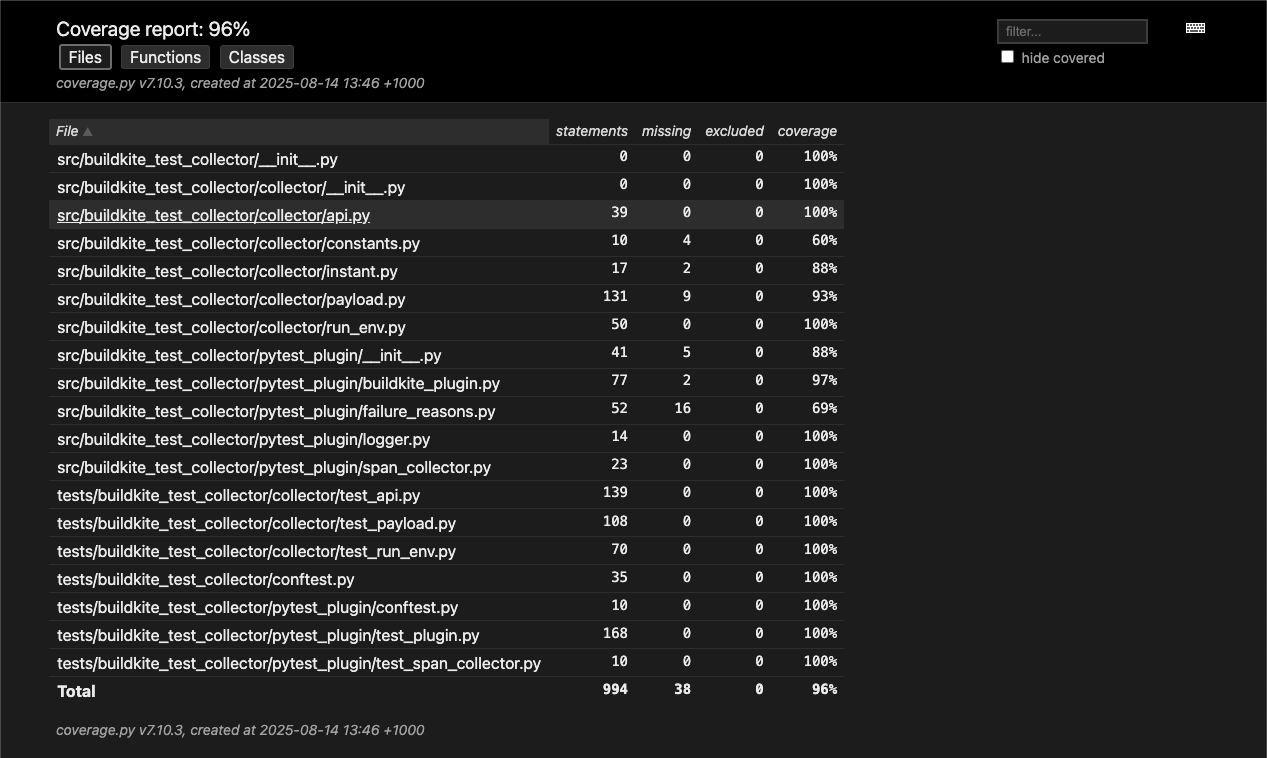
Patrick
NuGet ecosystem now supported by Package Registries
Announcing NuGet as the next supported ecosystem in Buildkite Package Registries
This allows you to use Buildkite as your registry for .NET packages, fully compatible with the latest v3 NuGet server specification
Ben
Webhook Notifications for Package Registries 🪝📦
We have added webhook notifications for package registries.
These provide the ability to fire webhook notifications whenever a new package gets created in a registry.
This building block can help trigger more event-based flows in software delivery, for instance triggering vulnerability scanners to run over every newly published package.
Available now for all supported ecosystems in Buildkite Package Registries. To get started checkout our webhook documentation.
Ben
Start turning complexity into an advantage
Create an account to get started for free.

